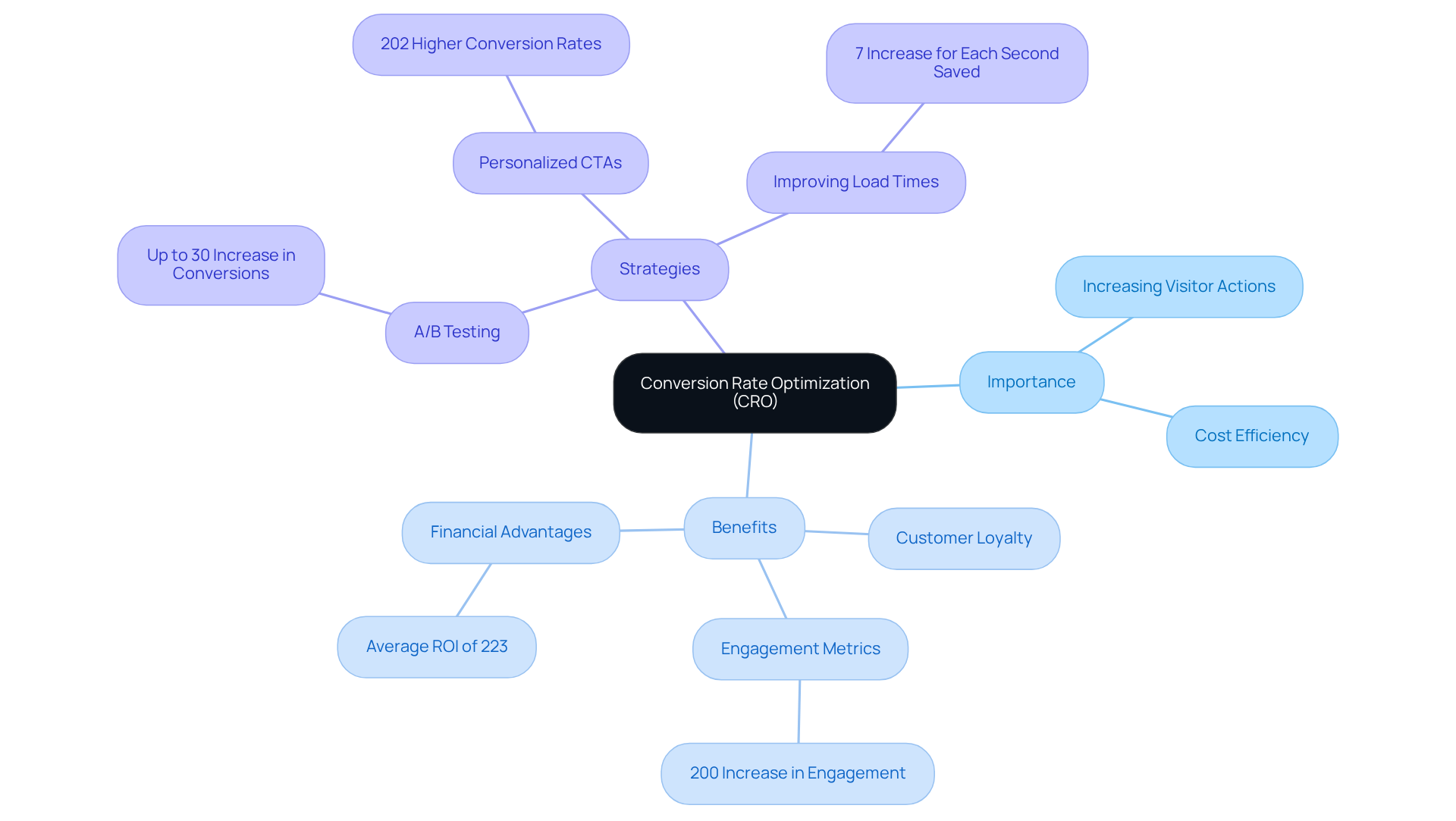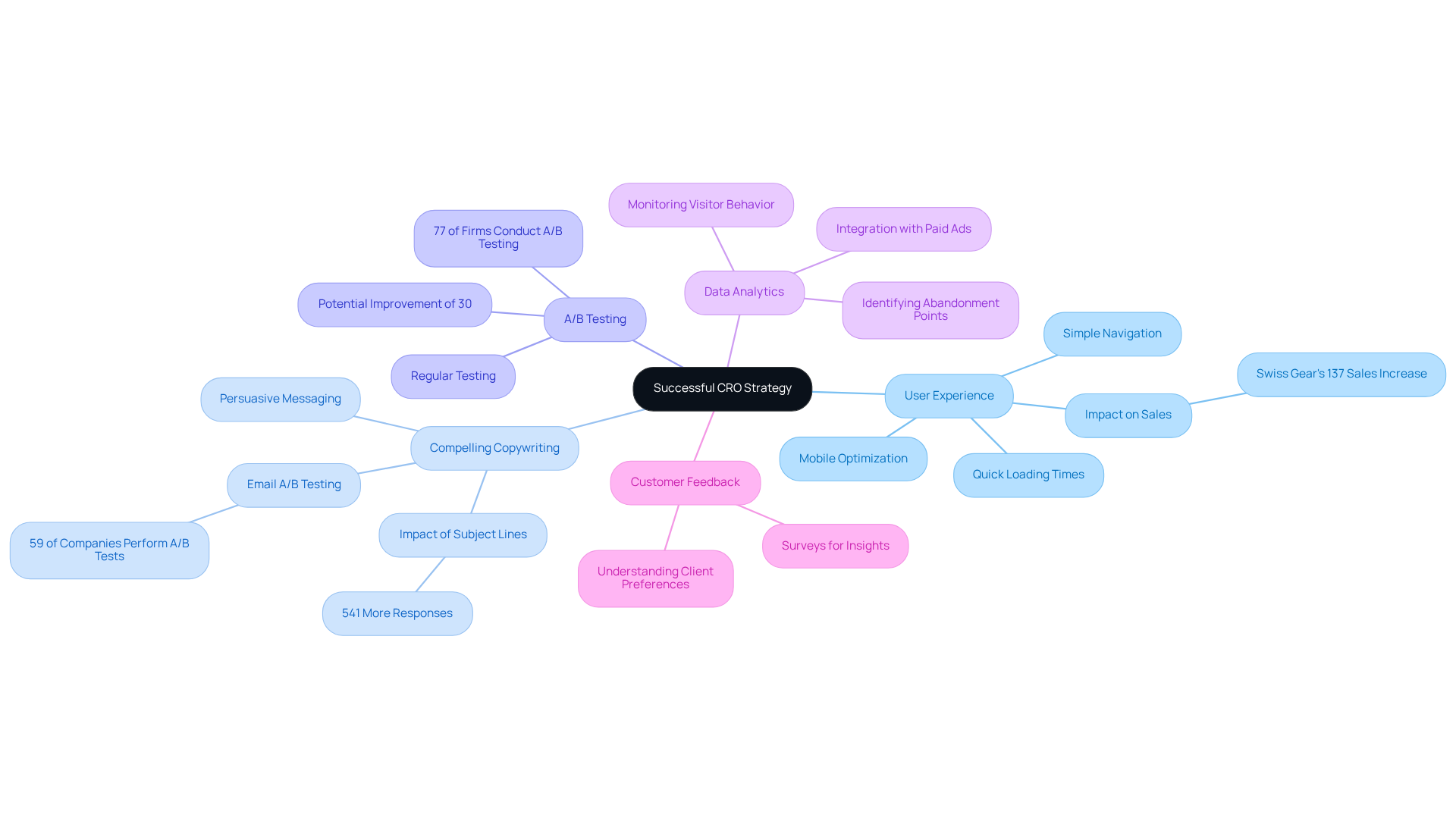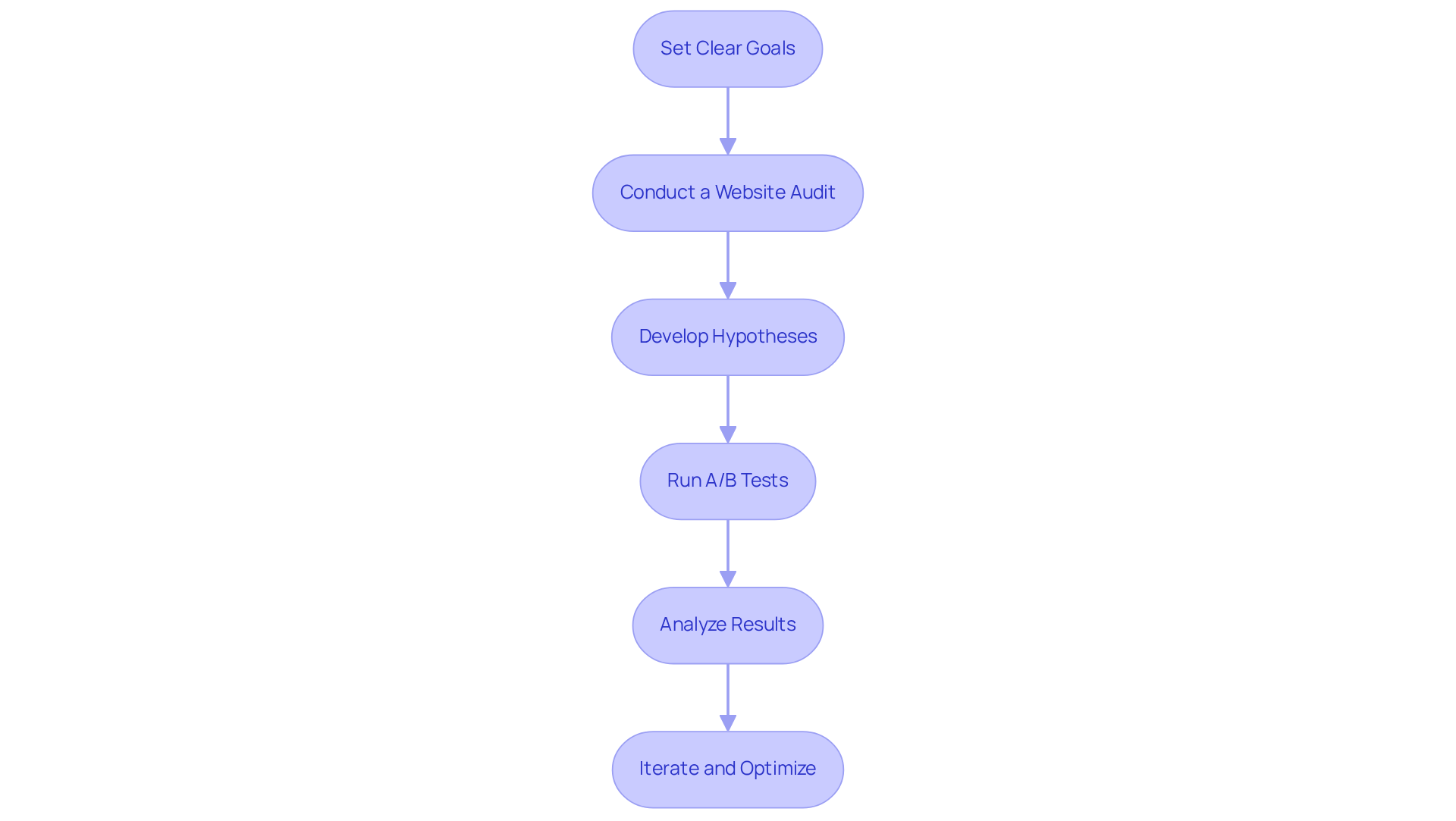
Overview
Mastering Conversion Rate Optimization (CRO) strategies is essential for the success of direct-to-consumer (DTC) brands. This mastery not only reduces customer acquisition costs but also enhances profitability. Key elements of a successful CRO strategy include:
- User experience
- Compelling copywriting
- A/B testing
- Data analytics
- Customer feedback
Each of these components plays a pivotal role in improving engagement and driving substantial financial returns.
To begin with, a seamless user experience is fundamental. It ensures that potential customers navigate easily through the purchasing process, reducing drop-off rates. Coupled with this is the necessity of compelling copywriting, which captures attention and persuades users to take action.
Furthermore, A/B testing allows brands to experiment with different strategies, identifying what resonates best with their audience. Data analytics provides insights into consumer behavior, enabling brands to make informed decisions. Lastly, customer feedback is invaluable; it offers direct insights into the customer’s perspective, allowing for continuous improvement.
In conclusion, implementing an effective CRO strategy is not merely an option but a necessity for DTC brands aiming for long-term success. By focusing on these key elements, brands can significantly enhance their engagement and profitability.
Introduction
Mastering the art of Conversion Rate Optimization (CRO) stands as a pivotal strategy for direct-to-consumer (DTC) brands navigating an increasingly competitive digital landscape. With customer acquisition costs soaring, the ability to convert existing traffic into sales or subscriptions is not merely advantageous—it's essential for sustainable growth. However, many brands struggle with effectively implementing CRO techniques that enhance profitability while fostering customer loyalty.
What are the key elements that can transform a DTC brand's approach to CRO? How can these elements be systematically integrated to ensure lasting success? By addressing these questions, brands can unlock the full potential of their online presence and drive meaningful results.
Define Conversion Rate Optimization and Its Importance
Conversion Rate Optimization (CRO) is a conversion rate optimization strategy aimed at increasing the percentage of website visitors who take desired actions, such as making purchases or subscribing to newsletters. For direct-to-consumer (DTC) brands, mastering CRO is essential, especially in an environment where customer acquisition costs are escalating. By effectively enhancing performance metrics through a conversion rate optimization strategy, brands can significantly augment the value derived from their existing traffic, ultimately leading to improved profitability without incurring additional advertising expenses.
Parah Group, an expert CRO agency, emphasizes profitability and sustainable growth. Our focus lies in strategies that not only boost revenue but also minimize costs and enhance margins. Our distinctive approach begins with an onboarding call with your CRO lead to lay the groundwork for long-term growth, followed by customized strategies tailored to your specific requirements. You have the flexibility to determine your level of involvement, ensuring that our communication style aligns with your preferences.
The benefits of a conversion rate optimization strategy extend beyond mere revenue enhancement; it is pivotal in cultivating customer loyalty and engagement. Brands that prioritize a conversion rate optimization strategy can create seamless experiences that encourage repeat visits and purchases. For instance, studies indicate that a well-optimized website can elevate engagement metrics by as much as 200%, underscoring the critical role of customer experience in driving sales.
Furthermore, implementing an effective conversion rate optimization strategy can yield substantial financial advantages. Companies that adopt structured CRO initiatives report an average return on investment (ROI) of approximately 223%. This statistic highlights the potential for profitability when brands concentrate on optimizing their digital presence. As DTC brands navigate the complexities of the digital marketplace, mastering a conversion rate optimization strategy with the expertise of agencies like Parah Group becomes not merely an option but a necessity for achieving sustainable growth and success.

Identify Key Elements of a Successful CRO Strategy
A successful CRO strategy encompasses several key elements:
-
User Experience (UX): A seamless and intuitive user experience is paramount. This encompasses quick loading times, simple navigation, and mobile optimization, which can lead to substantial growth in success metrics. For instance, enhancing product detail pages enabled Swiss Gear to achieve an impressive 137% rise in sales during peak shopping periods.
-
Compelling Copywriting: Persuasive and clear messaging significantly influences a visitor's decision to convert. Effective copywriting, particularly in call-to-action buttons and email subject lines, drives engagement; straightforward subject lines have been shown to elicit up to 541% more responses than more creative counterparts. Approximately 59% of companies perform email A/B tests to optimize their email marketing campaigns, demonstrating the effectiveness of A/B testing in enhancing persuasive messaging.
-
A/B Testing: Regularly testing different versions of web pages allows brands to identify what resonates best with their audience. About 77% of firms conduct A/B testing on their sites to improve customer interaction and sales rates, aiding in refining marketing strategies and enhancing visitor experiences. A/B testing can result in improvement increases of up to 30%, illustrating its essential role in enhancing performance.
-
Data Analytics: Employing analytics tools to monitor visitor behavior offers valuable insights into where individuals abandon the sales funnel. This data-focused method allows brands to make knowledgeable choices and apply modifications that improve experience and boost outcomes. Parah Group's holistic approach ensures that these insights are integrated into a comprehensive strategy that aligns paid ads and landing pages, maximizing profitability and demonstrating the long-term ROI of CRO compared to ad spend.
-
Customer Feedback: Gathering insights directly from customers through surveys can reveal pain points and areas for improvement. Understanding client preferences and behaviors is crucial for developing a website that fulfills customer needs efficiently. By concentrating on these aspects, DTC brands can build a solid base for their CRO initiatives, ultimately resulting in enhanced success metrics and greater profitability.

Implement a Step-by-Step Process for Effective CRO
To execute a successful CRO strategy, follow these crucial steps:
-
Set Clear Goals: Clearly define what success signifies for your brand—whether it's boosting sales, enhancing lead generation, or increasing audience engagement. Establishing specific, measurable goals acts as a guiding star for your optimization efforts.
-
Conduct a Website Audit: Analyze your current website performance to identify areas needing improvement. This audit should concentrate on metrics like transformation percentages, bounce figures, and user engagement levels.
-
Develop Hypotheses: Using your audit findings, create hypotheses about possible adjustments that could improve success metrics. For instance, if your analysis reveals high cart abandonment, consider testing a guest checkout option.
-
Run A/B Tests: Implement your hypotheses by creating variations of your web pages and measuring their performance against the original. A/B testing is an established technique that can greatly enhance success levels; even a 1% improvement can double your leads.
-
Analyze Results: Utilize analytics tools to assess the effect of your changes, concentrating on key metrics such as transformation statistics and average order values. This analysis will help you understand which strategies are most effective.
-
Iterate and Optimize: Based on your findings, make informed adjustments and continue testing to refine your strategy over time. This iterative process is crucial for adapting to evolving consumer behaviors and market trends, ensuring sustained growth and improved performance.

Leverage Data and User Insights for Continuous Improvement
To foster ongoing enhancement in your optimization efforts, it is essential to effectively utilize data and insights from individuals. Start by leveraging Google Analytics to monitor visitor behavior on your site, focusing on key metrics such as:
- Bounce rates
- Exit pages
- Conversion paths
These metrics play a crucial role in identifying potential bottlenecks in the client journey. Furthermore, conducting regular customer surveys yields qualitative data that illuminates user experiences and preferences, guiding your optimization strategies and informing future A/B tests. By cultivating a culture of data-driven decision-making, DTC brands can remain agile, adapting their strategies based on real-time insights and evolving consumer expectations. This proactive approach not only enhances conversion rates but also nurtures long-term customer relationships.

Conclusion
Mastering Conversion Rate Optimization (CRO) is not just a strategy; it is a vital necessity for direct-to-consumer (DTC) brands striving to excel in today’s competitive digital landscape. By enhancing the percentage of visitors who take desired actions, brands can significantly boost profitability without incurring additional advertising costs. This approach optimizes existing traffic while fostering customer loyalty and engagement, making it an indispensable component of a successful marketing strategy.
Throughout this article, we highlighted several key elements of an effective CRO strategy. These include:
- Creating an exceptional user experience
- Employing compelling copywriting
- Conducting A/B testing
- Leveraging data analytics
- Gathering customer feedback
Each component is crucial in understanding user behavior and refining marketing efforts to enhance conversion rates. Furthermore, we outlined a structured step-by-step process for implementing CRO, emphasizing the importance of:
- Setting clear goals
- Conducting audits
- Developing hypotheses
- Continuously optimizing based on data-driven insights
Ultimately, the significance of a well-executed CRO strategy cannot be overstated. As the digital marketplace evolves, DTC brands must adopt a proactive approach to optimization, utilizing data and user insights to inform their strategies. By committing to continuous improvement and leveraging the expertise of specialized agencies, brands can ensure sustainable growth, enhance customer experiences, and drive long-term success in an increasingly competitive environment. Embracing these practices positions brands not only for immediate gains but also cultivates a loyal customer base that is essential for future profitability.
Frequently Asked Questions
What is Conversion Rate Optimization (CRO)?
Conversion Rate Optimization (CRO) is a strategy aimed at increasing the percentage of website visitors who take desired actions, such as making purchases or subscribing to newsletters.
Why is CRO important for direct-to-consumer (DTC) brands?
CRO is essential for DTC brands because it helps them maximize the value derived from existing traffic, improving profitability without incurring additional advertising expenses, especially in an environment where customer acquisition costs are rising.
What approach does Parah Group take towards CRO?
Parah Group emphasizes profitability and sustainable growth through strategies that boost revenue while minimizing costs. Their approach includes an onboarding call to establish a foundation for long-term growth and customized strategies based on specific client needs.
How does CRO contribute to customer loyalty and engagement?
A well-executed CRO strategy enhances customer experience, leading to seamless interactions that encourage repeat visits and purchases, thereby cultivating customer loyalty and engagement.
What are the potential financial benefits of implementing CRO?
Companies that adopt structured CRO initiatives report an average return on investment (ROI) of approximately 223%, indicating significant financial advantages when focusing on optimizing their digital presence.
Why is mastering CRO considered a necessity for DTC brands?
As DTC brands navigate the complexities of the digital marketplace, mastering CRO with the help of expert agencies like Parah Group is crucial for achieving sustainable growth and success.
FAQs











